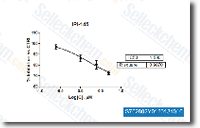oleracea miR NAs. To date, you will discover only 9 B. oleracea miRNAs collected in the miRBase database and Plant microRNA Database and with sequence coverage that differs by a max imum of two nucleotides. Tags that weren’t picked in this phase remained unannotated. Since a great deal from the B. oler acea genomic data continues to be missing, the reads filtering phase of the evaluation was repeated using the use of the Brassica rapa and Arabidopsis thaliana sequences. The decision of people organisms was dictated by the proven fact that all three plants belong for the Brassicaceae relatives, together with the split among the Brassica and Arabidopsis lineages getting approximately 20 million many years in the past. Moreover, their close homology, manifested by sequence similarity and conserved colinearity of gene order and material, continues to be verified in many scientific studies.
To take out tags that reveal homology to the A. thaliana and B. rapa tRNAs, rRNAs, snRNAs, snoRNAs and scRNAs, sequences of stated ncRNAs have been col lected and aligned together with the unannotated order inhibitor reads utilizing BlastN technique. All tags that possessed much less than three mismatches or gaps from the alignment and E worth didn’t exceed the 0. 01 threshold, had been removed from the information sets. A similar analysis was carried out for elimination in the repeat associated sequences and exons fragments. The BlastN approach which has a 0. 01 E worth threshold was employed. Reads with an alignment E worth under the threshold, that possessed no greater than three mismatches/gaps and with their sequence coverage differing by no greater than two nucleotides, were annotated as se quences homologous on the known plant miRNAs.
inhibitor SB 203580 MIRs which were not described in plants closely associated for the Brassicaceae and abundance of their identified members was under 15 reads, had been eliminated from ultimate miRNA households assortment. The remaining unannotated tags were more utilised to predict tasiRNAs and novel cabbage miRNAs. Prediction of novel miRNAs in cabbage leaves The primary phase within the prediction of new cabbage miRNAs was mapping from the unannotated tags on the B. oleracea contigs and singletons through the SOAP v1. 11 strategy no mismatches have been allowed, though the seed region size was set at 8. Special tags that completely matched these contigs and singletons were sub jected towards the up coming phase of analysis. The remaining reads were also mapped for the genomes in the A. thaliana and B. rapa.
The necessary genomic sequences were readily available at, whilst the mapping was carried out together with the SOAP v1. eleven and Bowtie 0. 12. eight soft ware. In each techniques, the parameters had been set so as to permit 1 mis match inside the alignment. In addition, for the SOAP v1. eleven device the seed region dimension was set at 8. For all mapped tags, representing likely new miRNAs, the hairpin pre cursors were produced  through the Mireap approach produced by the Beijing Genomics Institute and acknowledged secondary construction pre diction algorithms.
through the Mireap approach produced by the Beijing Genomics Institute and acknowledged secondary construction pre diction algorithms.
Met Receptor Signal
Cancer stem cells are thought to hijack the ability of normal stem cells to express MET.
